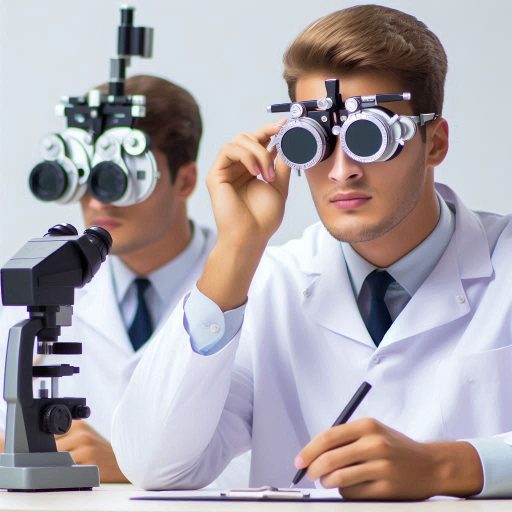Introduction
Optometry has a rich history, evolving from rudimentary vision correction to a comprehensive healthcare profession.
Early practices focused on simple lenses to improve sight, while modern optometry encompasses advanced diagnostics and treatments.
This transformation has made optometrists vital in managing eye health and vision care.
Advancements in optometry significantly enhance patient care.
Innovations in technology and research lead to better diagnostic tools, treatment options, and patient experiences.
New developments allow optometrists to diagnose conditions earlier and provide more effective treatments.
Staying up-to-date on the latest research and technology in optometry is crucial for professionals in the field.
Continuous education ensures optometrists understand emerging trends and techniques.
Embracing new technologies can improve patient outcomes and expand service offerings.
Additionally, being informed about advancements helps optometrists maintain a competitive edge in the healthcare landscape.
Patients increasingly seek practitioners who utilize the latest tools and techniques.
Therefore, ongoing education and adaptation to changes in the field are essential for success in optometry.
The history of optometry sets the stage for continuous advancements that shape patient care.
Optometrists must remain informed and adaptable to provide the best services.
The Role of Artificial Intelligence in Optometry
Artificial intelligence (AI) is transforming optometry by enhancing the diagnosis and management of eye diseases.
Optometrists increasingly rely on AI to analyze data and detect abnormalities with precision.
AI systems can process large amounts of data quickly, identifying patterns that might go unnoticed by the human eye.
How AI is being used in diagnosing and managing eye diseases
AI in Diagnosing Eye Diseases
AI significantly improves the early detection of eye diseases such as glaucoma, diabetic retinopathy, and age-related macular degeneration.
Using deep learning algorithms, AI can analyze retinal images and detect subtle changes in eye structures.
This capability allows optometrists to diagnose diseases in their earliest stages, improving treatment outcomes.
AI tools assist optometrists by offering second opinions and reducing diagnostic errors.
These systems learn from vast datasets and become more accurate over time.
As a result, patients receive more reliable diagnoses and faster treatment recommendations.
AI in Managing Eye Conditions
AI also plays a key role in managing chronic eye conditions.
For example, AI-powered platforms monitor disease progression and suggest personalized treatment plans.
By continuously analyzing patient data, these systems help optometrists make timely adjustments to care plans.
This personalized approach leads to better outcomes and greater patient satisfaction.
In addition, AI-powered tools assist with patient education by providing clear and accessible explanations of their condition and treatment options.
This increases patient understanding and engagement in their care, improving overall health outcomes.
Benefits of AI in Optometric Practice
AI offers several benefits to optometric practices, particularly in improving accuracy and efficiency.
One of the most significant advantages is the reduction in diagnostic errors.
AI systems can detect small changes in eye health that might be missed during a manual exam.
This heightened level of precision ensures that patients receive timely interventions, reducing the risk of complications.
Another major benefit is the increase in efficiency.
AI-powered diagnostic tools enable optometrists to assess more patients in less time without sacrificing quality.
Automating routine tasks, such as image analysis, frees up time for optometrists to focus on direct patient care.
As a result, clinics can serve more patients while maintaining high standards of care.
AI also enhances the ability of optometrists to provide personalized care.
By analyzing a patient’s unique data, AI systems suggest tailored treatment plans, leading to more effective interventions.
This customization improves patient satisfaction and fosters better long-term relationships between optometrists and their patients.
Artificial intelligence is revolutionizing optometry by improving both diagnostic accuracy and the management of eye diseases.
AI empowers optometrists to detect conditions earlier, make data-driven treatment decisions, and enhance patient care.
As AI technology continues to evolve, its role in optometry will only grow, offering more opportunities for improved patient outcomes and practice efficiency.
Read: Profiles in Success: Leading Chemists of the 21st Century in the US
Telemedicine in Optometry
How Telemedicine is Revolutionizing the Way Patients Receive Eye Care
Telemedicine is revolutionizing how patients receive eye care.
It enables optometrists to provide consultations, diagnoses, and follow-ups remotely.
This innovation improves access to eye care, especially for those in underserved areas.
Patients can now connect with optometrists from the comfort of their homes.
Telemedicine saves time and reduces the need for travel, which can be particularly beneficial for elderly patients.
Improving Access to Eye Care
Telemedicine bridges the gap for patients who face geographical barriers.
People living in rural areas often struggle to find local optometrists.
Telemedicine allows these individuals to receive care without traveling long distances.
This convenience increases patient engagement and encourages regular eye exams.
Additionally, telemedicine caters to patients with mobility issues.
Individuals with disabilities or chronic conditions can benefit significantly from remote consultations.
By reducing barriers to care, telemedicine fosters inclusivity in eye health services.
The Telehealth Process in Optometry
The telehealth process in optometry typically begins with an online appointment.
Patients submit their health history and any current concerns.
Optometrists then review this information before the consultation.
During the virtual visit, practitioners can assess symptoms and recommend further action.
This might include prescribing medications, suggesting lifestyle changes, or scheduling in-person visits.
Telemedicine also allows optometrists to monitor patients with chronic conditions.
By using remote monitoring tools, practitioners can track disease progression over time.
This ongoing assessment enables timely interventions and better management of conditions like glaucoma or diabetic retinopathy.
Challenges and Opportunities of Telemedicine in Optometry
Challenges of telemedicine in optometry
Despite its benefits, telemedicine in optometry faces several challenges.
One major issue is the need for reliable technology.
Both patients and optometrists require access to stable internet connections and compatible devices.
Technical difficulties can disrupt consultations and hinder patient care.
Another challenge is the limited scope of certain eye examinations.
While telemedicine is effective for many conditions, some require in-person assessments.
For example, comprehensive eye exams involve equipment that is not available remotely.
Optometrists must determine when to refer patients for in-person evaluations to ensure proper care.
Opportunities for Growth
Despite these challenges, telemedicine presents numerous opportunities for growth in optometry.
As technology continues to advance, the quality of remote care will improve.
Innovations in digital tools will enhance diagnostic capabilities and streamline patient interactions.
Moreover, telemedicine can facilitate interdisciplinary collaboration.
Optometrists can work alongside other healthcare providers to deliver comprehensive patient care.
This integrated approach can lead to better health outcomes and more efficient treatment plans.
Telemedicine also offers potential for increased patient retention.
Practices can engage patients through follow-up appointments and educational resources.
This ongoing relationship fosters loyalty and encourages patients to prioritize their eye health.
Telemedicine is transforming optometry by improving access to eye care.
While challenges exist, the opportunities for growth and innovation are immense.
Embracing telemedicine allows optometrists to enhance patient care and adapt to changing healthcare demands.
Read: The Life and Times of a U.S. Physicist: A Day in Detail
Advancements in Contact Lens Technology
Latest Developments in Contact Lens Materials and Designs
Contact lens technology has evolved significantly in recent years.
Manufacturers now use advanced materials that enhance comfort and performance.
Silicone hydrogel lenses have become popular due to their high oxygen permeability.
This material allows more oxygen to reach the cornea, promoting eye health.
Additionally, new designs focus on improved fitting and functionality.
Some contact lenses feature customized shapes to accommodate various eye geometries.
These tailored lenses provide better stability and minimize lens movement during blinking.
As a result, patients experience fewer discomfort and visual disturbances.
Another exciting development is the introduction of multifocal contact lenses.
These lenses correct presbyopia by offering multiple focal points.
Patients can see clearly at different distances without needing reading glasses.
Modern multifocal lenses are thinner and more comfortable than their predecessors, making them a popular choice.
Furthermore, innovations in lens coatings enhance their performance.
Anti-reflective coatings reduce glare, improving visual clarity.
Scratch-resistant coatings increase durability, extending the lifespan of contact lenses.
These advancements provide patients with better visual outcomes and longer-lasting products.
Transform Your Career Today
Unlock a personalized career strategy that drives real results. Get tailored advice and a roadmap designed just for you.
Start NowImproving Comfort and Visual Outcomes for Patients
Patient comfort is a primary focus in contact lens development.
Many new lenses incorporate wetting agents to enhance hydration.
These agents help keep the lenses moist, reducing dryness and irritation.
As a result, patients can wear their lenses for extended periods without discomfort.
Additionally, manufacturers are developing daily disposable lenses.
These lenses offer convenience and hygiene benefits.
Patients can discard lenses after a single use, eliminating cleaning and storage hassles.
Daily disposables are especially beneficial for individuals with allergies or sensitive eyes.
Comfort-enhancing technologies also include improved edge designs.
Softer edges reduce friction between the lens and eyelid.
This design minimizes irritation during blinking, leading to a more comfortable wearing experience.
Moreover, advancements in digital eye strain management are noteworthy.
With increased screen time, many patients experience discomfort.
Some lenses now incorporate blue light-filtering technology.
This technology helps reduce eye fatigue associated with prolonged digital device usage.
The latest contact lenses also address specific vision correction needs.
For instance, lenses designed for astigmatism feature innovative stabilization designs.
These lenses remain correctly oriented on the eye, providing clear vision for astigmatic patients.
Additionally, some contact lenses now offer UV protection.
This feature shields the eyes from harmful ultraviolet rays.
Patients can enjoy outdoor activities without worrying about sun damage to their eyes.
Advancements in contact lens technology greatly enhance comfort and visual outcomes for patients.
Improved materials, designs, and features address the diverse needs of wearers.
As technology continues to evolve, patients can expect even more innovative solutions in contact lens care.
This progress ultimately leads to a more satisfying experience for contact lens users.
Read: Salary Ranges: What to Expect as a Physicist in the USA

Genetic Testing in Optometry
The Role of Genetic Testing in Identifying Hereditary Eye Conditions
Genetic testing plays a significant role in optometry.
It helps identify hereditary eye conditions that may affect patients.
These tests analyze DNA to pinpoint genetic mutations linked to eye diseases.
Early detection of these conditions can lead to timely interventions.
Several hereditary eye conditions can benefit from genetic testing.
For instance, retinitis pigmentosa is a progressive eye disorder affecting vision.
Genetic testing can confirm the diagnosis and identify specific gene mutations.
This information aids in understanding the disease’s progression and potential outcomes.
Another condition is age-related macular degeneration (AMD).
Genetic testing can help assess an individual‘s risk for developing AMD.
By identifying genetic markers associated with AMD, healthcare providers can offer preventive strategies.
Moreover, genetic testing can reveal a family history of eye diseases.
This information allows patients to make informed decisions about their eye health.
For example, individuals with a family history of glaucoma can undergo regular screenings.
Early detection can prevent vision loss from this potentially debilitating condition.
Genetic testing also assists in diagnosing conditions like congenital cataracts.
Identifying the genetic basis for these cataracts helps determine the best treatment options.
This information can significantly influence the timing and approach for surgical interventions.
Implications of Genetic Testing for Personalized Treatment Plans in Optometry
Genetic testing paves the way for personalized treatment plans in optometry.
By understanding a patient’s genetic predispositions, eye care professionals can tailor their approaches.
This personalization enhances treatment effectiveness and improves patient outcomes.
For instance, if genetic testing reveals a patient is predisposed to certain eye diseases, proactive measures can be taken.
Eye care providers may recommend more frequent eye exams or lifestyle changes to mitigate risks.
Personalized advice empowers patients to take control of their eye health.
Furthermore, genetic information can guide the choice of therapeutic interventions.
For patients with inherited retinal diseases, specific treatments may be more effective based on genetic profiles.
Personalized treatment strategies increase the likelihood of successful outcomes.
In addition, genetic testing can help identify potential adverse reactions to specific medications.
Understanding a patient’s genetic makeup enables healthcare providers to prescribe the safest and most effective treatments.
This personalized approach minimizes the risk of complications.
Additionally, genetic testing can facilitate participation in clinical trials.
Patients with specific genetic mutations may qualify for new therapies under investigation.
This access can provide opportunities for innovative treatments not yet available to the general public.
As technology advances, genetic testing in optometry will continue to evolve.
The integration of genetic insights into routine eye care practices will become increasingly common.
This shift will ultimately enhance patient care and drive advancements in optometric treatments.
Genetic testing significantly impacts optometry.
It enables the identification of hereditary eye conditions and informs personalized treatment plans.
As optometry embraces these advancements, patient outcomes will improve, leading to better overall eye health.
Read: Physics Specializations: Choosing Your Path in the U.S.
Learn More: Climatology Conferences and Events to Attend
Augmented Reality in Optometric Education
Enhancing Optometric Education and Training with Augmented Reality
Augmented reality (AR) is transforming optometric education and training.
This technology blends digital information with the real world, enhancing learning experiences.
Students can interact with 3D models of the eye, improving their understanding of complex structures.
This interactive approach engages learners more effectively than traditional methods.
Several educational institutions are integrating AR into their curricula.
For instance, AR applications allow students to visualize anatomical features of the eye.
By overlaying digital images onto physical models, learners can explore the eye‘s components in detail.
This hands-on experience deepens their understanding of ocular anatomy and physiology.
AR also aids in simulating real-life patient interactions.
Students can practice conducting eye exams in a controlled environment.
These simulations enhance their clinical skills before working with actual patients.
This approach reduces anxiety and builds confidence in future practitioners.
Furthermore, AR technology enables remote learning opportunities.
Students can participate in interactive lessons from anywhere in the world.
This flexibility expands access to quality education for aspiring optometrists.
They can learn at their own pace while still receiving guidance from instructors.
Additionally, AR facilitates collaborative learning experiences.
Students can work together on projects, sharing insights and knowledge.
This teamwork fosters critical thinking and problem-solving skills, essential for future optometrists.
The Potential Impact of AR Technology on the Future of Optometry
The integration of augmented reality in optometric education promises significant benefits.
As AR technology advances, its applications in training will expand.
This growth will shape the future of optometry in various ways.
One potential impact is the enhancement of patient education.
Optometrists can use AR to explain eye conditions to patients visually.
By displaying 3D models of the eye, patients can better understand their diagnoses and treatment options.
This increased understanding can lead to improved patient compliance and satisfaction.
Moreover, AR can support ongoing professional development for practicing optometrists.
Continuing education programs can incorporate AR simulations to keep professionals updated on the latest techniques.
This technology allows optometrists to refine their skills in a risk-free environment.
Additionally, AR can facilitate telehealth consultations.
Optometrists can use AR tools to guide patients through self-examinations at home.
This approach can enhance patient engagement and provide valuable data for remote assessments.
Furthermore, AR may play a role in enhancing the efficiency of optometric practices.
For example, AR can assist in training staff on new equipment and procedures.
This efficiency can lead to better patient experiences and streamlined workflows.
Augmented reality is revolutionizing optometric education and training.
Its ability to enhance learning experiences and facilitate patient education is invaluable.
As AR technology continues to evolve, it will significantly impact the future of optometry.
The integration of AR will empower both students and practitioners, ultimately improving patient care in the field.
Innovations in Refractive Surgery
Latest Advancements in LASIK and Other Refractive Procedures
Refractive surgery continues to evolve with remarkable innovations.
LASIK remains one of the most popular options for vision correction.
Recent advancements in LASIK technology enhance accuracy and safety.
Newer laser systems provide more precise corneal reshaping.
These systems use wavefront-guided technology, allowing for customized treatment plans.
Another significant advancement is the introduction of SMILE (Small Incision Lenticule Extraction).
This minimally invasive technique involves creating a small incision in the cornea.
Surgeons then remove a lenticule to reshape the cornea.
Patients benefit from reduced recovery times and less postoperative discomfort.
SMILE also lowers the risk of dry eye compared to traditional LASIK.
Moreover, enhancements in diagnostic tools improve preoperative evaluations.
Advanced imaging techniques allow for a detailed mapping of the cornea.
This information ensures personalized treatment plans tailored to individual needs.
Enhanced diagnostics lead to better outcomes and higher patient satisfaction.
Other refractive procedures, like PRK (Photorefractive Keratectomy), also see innovations.
New techniques minimize discomfort and speed up recovery.
These advancements make PRK a viable option for patients unsuitable for LASIK.
Benefits and Risks of Innovations for Patients Seeking Vision Correction
Patients seeking vision correction experience numerous benefits from these innovations.
Enhanced safety features significantly reduce the likelihood of complications.
Most patients achieve 20/25 vision or better after surgery, enhancing their quality of life.
Additionally, these advancements allow for faster recovery times.
Many patients return to normal activities within a day or two.
This quick recovery is particularly appealing for busy individuals.
Patients also enjoy a broader range of options.
Innovations in refractive surgery provide choices for various vision problems.
Those with higher prescriptions or irregular corneas can benefit from new techniques.
Tailored solutions ensure patients receive the best possible care.
However, risks still exist with refractive surgery.
Complications, though rare, can occur.
These include dry eyes, glare, and halos around lights.
Patients must discuss these risks with their surgeons before proceeding.
Moreover, not all patients are suitable candidates for surgery.
Factors such as age, eye health, and prescription stability play a role.
Potential patients should undergo thorough evaluations to determine eligibility.
Long-term effects of new procedures remain a concern.
While many innovations show promising results, extensive studies are ongoing.
Patients should seek information from reputable sources and healthcare professionals.
Innovations in refractive surgery, particularly LASIK and SMILE, offer significant advancements.
These technologies enhance patient outcomes, safety, and satisfaction.
Patients seeking vision correction can benefit from various options tailored to their needs.
However, it is crucial to weigh the benefits and risks carefully.
Informed decision-making empowers patients to choose the best path for their vision correction journey.
Conclusion
This blog post explored key advancements in optometry, highlighting technologies like artificial intelligence, telemedicine, and genetic testing.
We discussed how artificial intelligence improves diagnostic accuracy and efficiency in eye care.
Telemedicine revolutionizes patient access to optometric services, offering convenience and flexibility.
Genetic testing allows optometrists to identify hereditary eye conditions, enabling personalized treatment plans for patients.
Innovations in refractive surgery, including LASIK and SMILE, provide effective vision correction options with faster recovery times.
Additionally, augmented reality enhances optometric education and training, preparing future practitioners for the evolving field.
Each of these advancements contributes to improving patient outcomes and experiences.
Embracing these innovations is crucial for optometrists.
By integrating the latest technologies, practitioners can provide the best possible care for their patients.
Adapting to advancements ensures that optometrists remain at the forefront of eye care.
As the field of optometry continues to evolve, staying informed about these trends is essential.
Optometrists must invest in ongoing education and training to implement new technologies effectively.
By doing so, they can enhance their practice and offer superior eye care to their patients.
The future of optometry is bright, driven by innovation and a commitment to excellence.




